Evidence-Based Practice in Nursing Research: HFT Implementation
VerifiedAdded on 2023/06/14
|16
|4685
|260
Essay
AI Summary
This essay explores the application of evidence-based practice (EBP) in healthcare, specifically within the operational theatre. It focuses on the risks faced by surgical personnel, such as exposure to pathogens and sharps injuries, and examines the effectiveness of hands-free techniques (HFT) in reducing these risks compared to traditional hand-to-hand instrument passing. The essay synthesizes research studies, utilizing the Hopkins Nursing Evidence-Based Practice model, to highlight the influence of healthcare workers' perceptions on HFT adoption. It details a search strategy employing the PICOT tool to analyze data from various hospitals, assessing the impact of HFT implementation on percutaneous injuries and contamination rates. The intervention involved educating healthcare workers about the benefits of HFT, supported by video resources and interactive teamwork. Furthermore, the essay includes a critical appraisal of qualitative and quantitative research reports, using critical analysis tools (CATs) to evaluate the validity and authenticity of articles related to nursing safety and injury prevention in the operating room.
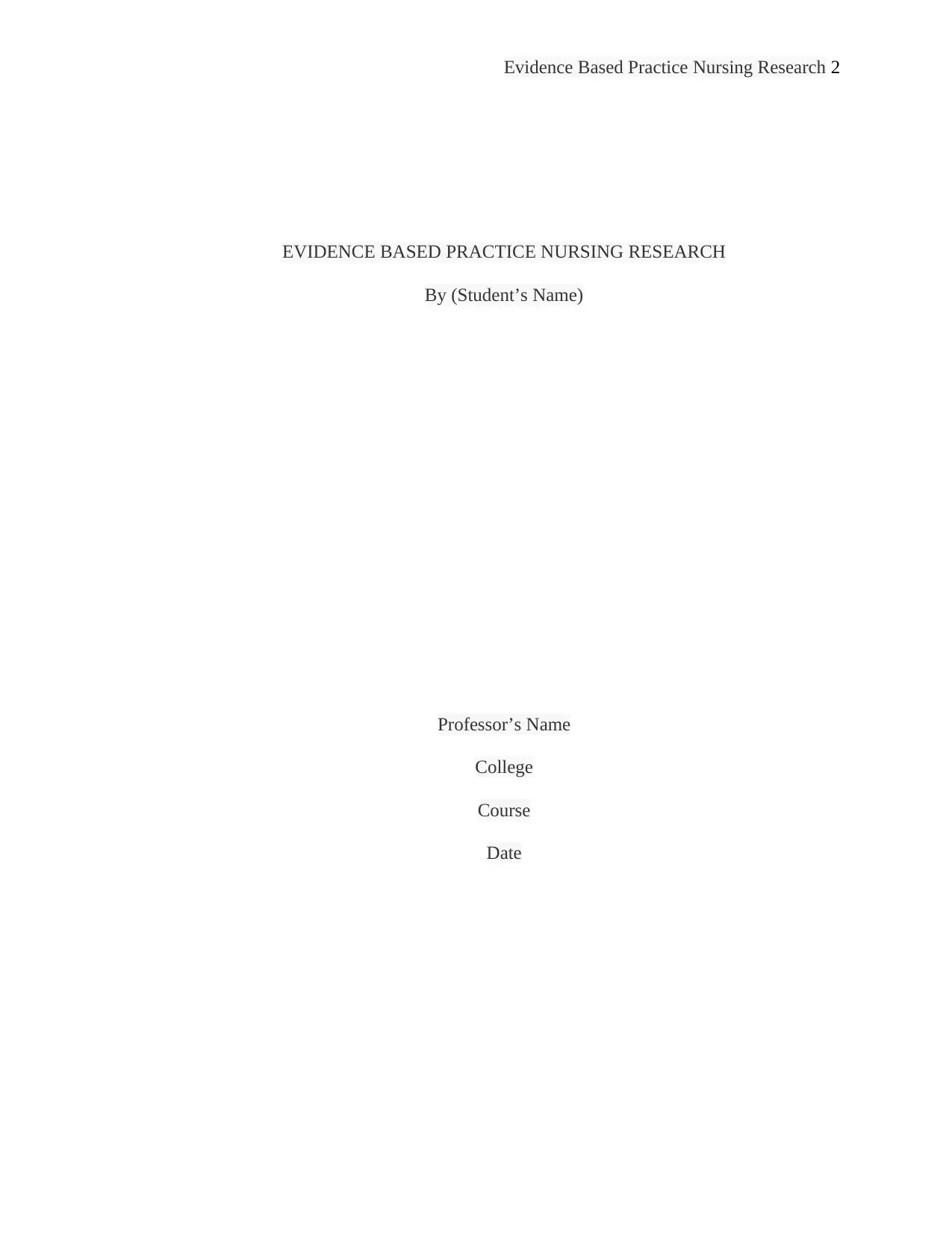
Evidence Based Practice Nursing Research 2
EVIDENCE BASED PRACTICE NURSING RESEARCH
By (Student’s Name)
Professor’s Name
College
Course
Date
EVIDENCE BASED PRACTICE NURSING RESEARCH
By (Student’s Name)
Professor’s Name
College
Course
Date
Paraphrase This Document
Need a fresh take? Get an instant paraphrase of this document with our AI Paraphraser
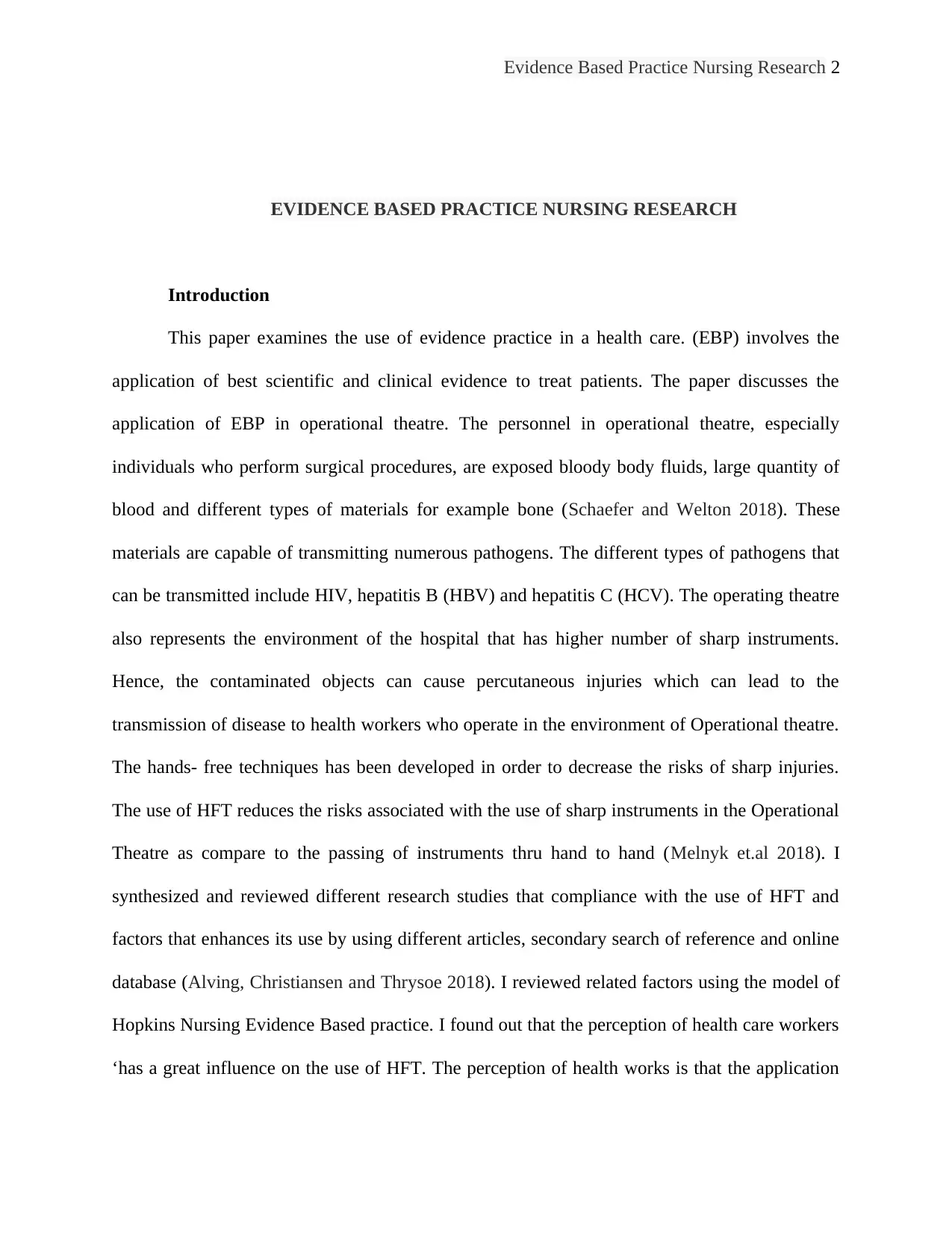
Evidence Based Practice Nursing Research 2
EVIDENCE BASED PRACTICE NURSING RESEARCH
Introduction
This paper examines the use of evidence practice in a health care. (EBP) involves the
application of best scientific and clinical evidence to treat patients. The paper discusses the
application of EBP in operational theatre. The personnel in operational theatre, especially
individuals who perform surgical procedures, are exposed bloody body fluids, large quantity of
blood and different types of materials for example bone (Schaefer and Welton 2018). These
materials are capable of transmitting numerous pathogens. The different types of pathogens that
can be transmitted include HIV, hepatitis B (HBV) and hepatitis C (HCV). The operating theatre
also represents the environment of the hospital that has higher number of sharp instruments.
Hence, the contaminated objects can cause percutaneous injuries which can lead to the
transmission of disease to health workers who operate in the environment of Operational theatre.
The hands- free techniques has been developed in order to decrease the risks of sharp injuries.
The use of HFT reduces the risks associated with the use of sharp instruments in the Operational
Theatre as compare to the passing of instruments thru hand to hand (Melnyk et.al 2018). I
synthesized and reviewed different research studies that compliance with the use of HFT and
factors that enhances its use by using different articles, secondary search of reference and online
database (Alving, Christiansen and Thrysoe 2018). I reviewed related factors using the model of
Hopkins Nursing Evidence Based practice. I found out that the perception of health care workers
‘has a great influence on the use of HFT. The perception of health works is that the application
EVIDENCE BASED PRACTICE NURSING RESEARCH
Introduction
This paper examines the use of evidence practice in a health care. (EBP) involves the
application of best scientific and clinical evidence to treat patients. The paper discusses the
application of EBP in operational theatre. The personnel in operational theatre, especially
individuals who perform surgical procedures, are exposed bloody body fluids, large quantity of
blood and different types of materials for example bone (Schaefer and Welton 2018). These
materials are capable of transmitting numerous pathogens. The different types of pathogens that
can be transmitted include HIV, hepatitis B (HBV) and hepatitis C (HCV). The operating theatre
also represents the environment of the hospital that has higher number of sharp instruments.
Hence, the contaminated objects can cause percutaneous injuries which can lead to the
transmission of disease to health workers who operate in the environment of Operational theatre.
The hands- free techniques has been developed in order to decrease the risks of sharp injuries.
The use of HFT reduces the risks associated with the use of sharp instruments in the Operational
Theatre as compare to the passing of instruments thru hand to hand (Melnyk et.al 2018). I
synthesized and reviewed different research studies that compliance with the use of HFT and
factors that enhances its use by using different articles, secondary search of reference and online
database (Alving, Christiansen and Thrysoe 2018). I reviewed related factors using the model of
Hopkins Nursing Evidence Based practice. I found out that the perception of health care workers
‘has a great influence on the use of HFT. The perception of health works is that the application
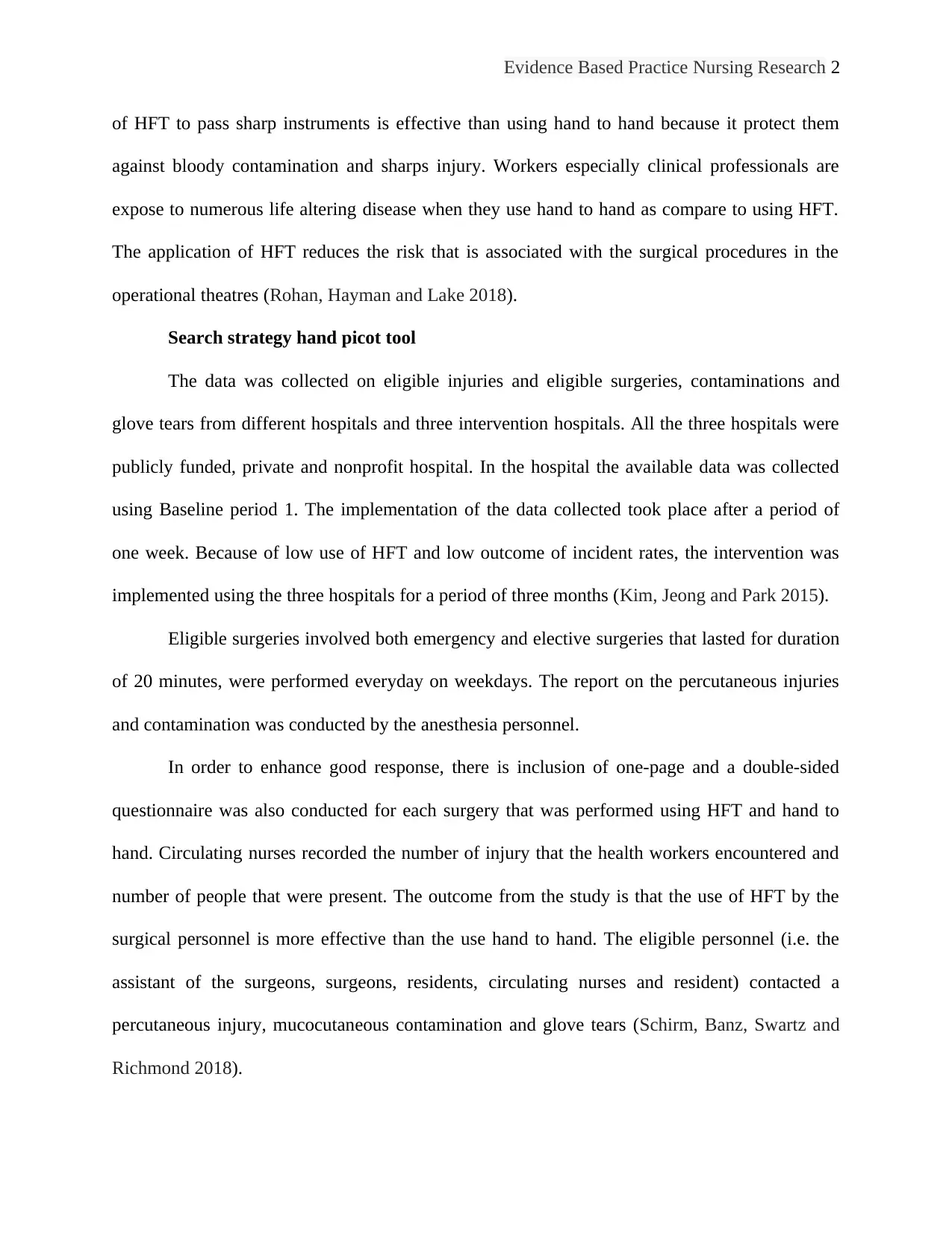
Evidence Based Practice Nursing Research 2
of HFT to pass sharp instruments is effective than using hand to hand because it protect them
against bloody contamination and sharps injury. Workers especially clinical professionals are
expose to numerous life altering disease when they use hand to hand as compare to using HFT.
The application of HFT reduces the risk that is associated with the surgical procedures in the
operational theatres (Rohan, Hayman and Lake 2018).
Search strategy hand picot tool
The data was collected on eligible injuries and eligible surgeries, contaminations and
glove tears from different hospitals and three intervention hospitals. All the three hospitals were
publicly funded, private and nonprofit hospital. In the hospital the available data was collected
using Baseline period 1. The implementation of the data collected took place after a period of
one week. Because of low use of HFT and low outcome of incident rates, the intervention was
implemented using the three hospitals for a period of three months (Kim, Jeong and Park 2015).
Eligible surgeries involved both emergency and elective surgeries that lasted for duration
of 20 minutes, were performed everyday on weekdays. The report on the percutaneous injuries
and contamination was conducted by the anesthesia personnel.
In order to enhance good response, there is inclusion of one-page and a double-sided
questionnaire was also conducted for each surgery that was performed using HFT and hand to
hand. Circulating nurses recorded the number of injury that the health workers encountered and
number of people that were present. The outcome from the study is that the use of HFT by the
surgical personnel is more effective than the use hand to hand. The eligible personnel (i.e. the
assistant of the surgeons, surgeons, residents, circulating nurses and resident) contacted a
percutaneous injury, mucocutaneous contamination and glove tears (Schirm, Banz, Swartz and
Richmond 2018).
of HFT to pass sharp instruments is effective than using hand to hand because it protect them
against bloody contamination and sharps injury. Workers especially clinical professionals are
expose to numerous life altering disease when they use hand to hand as compare to using HFT.
The application of HFT reduces the risk that is associated with the surgical procedures in the
operational theatres (Rohan, Hayman and Lake 2018).
Search strategy hand picot tool
The data was collected on eligible injuries and eligible surgeries, contaminations and
glove tears from different hospitals and three intervention hospitals. All the three hospitals were
publicly funded, private and nonprofit hospital. In the hospital the available data was collected
using Baseline period 1. The implementation of the data collected took place after a period of
one week. Because of low use of HFT and low outcome of incident rates, the intervention was
implemented using the three hospitals for a period of three months (Kim, Jeong and Park 2015).
Eligible surgeries involved both emergency and elective surgeries that lasted for duration
of 20 minutes, were performed everyday on weekdays. The report on the percutaneous injuries
and contamination was conducted by the anesthesia personnel.
In order to enhance good response, there is inclusion of one-page and a double-sided
questionnaire was also conducted for each surgery that was performed using HFT and hand to
hand. Circulating nurses recorded the number of injury that the health workers encountered and
number of people that were present. The outcome from the study is that the use of HFT by the
surgical personnel is more effective than the use hand to hand. The eligible personnel (i.e. the
assistant of the surgeons, surgeons, residents, circulating nurses and resident) contacted a
percutaneous injury, mucocutaneous contamination and glove tears (Schirm, Banz, Swartz and
Richmond 2018).
⊘ This is a preview!⊘
Do you want full access?
Subscribe today to unlock all pages.

Trusted by 1+ million students worldwide
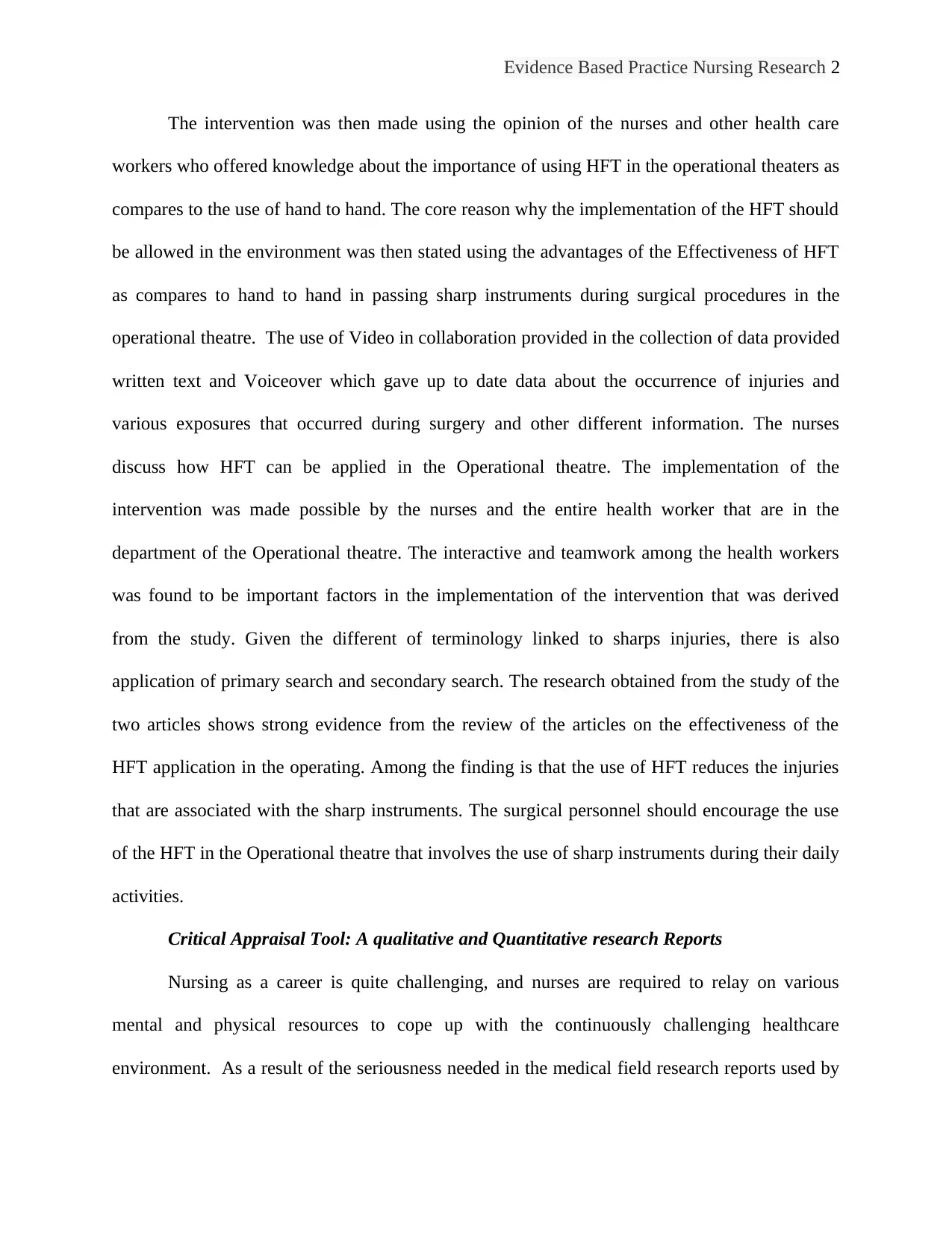
Evidence Based Practice Nursing Research 2
The intervention was then made using the opinion of the nurses and other health care
workers who offered knowledge about the importance of using HFT in the operational theaters as
compares to the use of hand to hand. The core reason why the implementation of the HFT should
be allowed in the environment was then stated using the advantages of the Effectiveness of HFT
as compares to hand to hand in passing sharp instruments during surgical procedures in the
operational theatre. The use of Video in collaboration provided in the collection of data provided
written text and Voiceover which gave up to date data about the occurrence of injuries and
various exposures that occurred during surgery and other different information. The nurses
discuss how HFT can be applied in the Operational theatre. The implementation of the
intervention was made possible by the nurses and the entire health worker that are in the
department of the Operational theatre. The interactive and teamwork among the health workers
was found to be important factors in the implementation of the intervention that was derived
from the study. Given the different of terminology linked to sharps injuries, there is also
application of primary search and secondary search. The research obtained from the study of the
two articles shows strong evidence from the review of the articles on the effectiveness of the
HFT application in the operating. Among the finding is that the use of HFT reduces the injuries
that are associated with the sharp instruments. The surgical personnel should encourage the use
of the HFT in the Operational theatre that involves the use of sharp instruments during their daily
activities.
Critical Appraisal Tool: A qualitative and Quantitative research Reports
Nursing as a career is quite challenging, and nurses are required to relay on various
mental and physical resources to cope up with the continuously challenging healthcare
environment. As a result of the seriousness needed in the medical field research reports used by
The intervention was then made using the opinion of the nurses and other health care
workers who offered knowledge about the importance of using HFT in the operational theaters as
compares to the use of hand to hand. The core reason why the implementation of the HFT should
be allowed in the environment was then stated using the advantages of the Effectiveness of HFT
as compares to hand to hand in passing sharp instruments during surgical procedures in the
operational theatre. The use of Video in collaboration provided in the collection of data provided
written text and Voiceover which gave up to date data about the occurrence of injuries and
various exposures that occurred during surgery and other different information. The nurses
discuss how HFT can be applied in the Operational theatre. The implementation of the
intervention was made possible by the nurses and the entire health worker that are in the
department of the Operational theatre. The interactive and teamwork among the health workers
was found to be important factors in the implementation of the intervention that was derived
from the study. Given the different of terminology linked to sharps injuries, there is also
application of primary search and secondary search. The research obtained from the study of the
two articles shows strong evidence from the review of the articles on the effectiveness of the
HFT application in the operating. Among the finding is that the use of HFT reduces the injuries
that are associated with the sharp instruments. The surgical personnel should encourage the use
of the HFT in the Operational theatre that involves the use of sharp instruments during their daily
activities.
Critical Appraisal Tool: A qualitative and Quantitative research Reports
Nursing as a career is quite challenging, and nurses are required to relay on various
mental and physical resources to cope up with the continuously challenging healthcare
environment. As a result of the seriousness needed in the medical field research reports used by
Paraphrase This Document
Need a fresh take? Get an instant paraphrase of this document with our AI Paraphraser
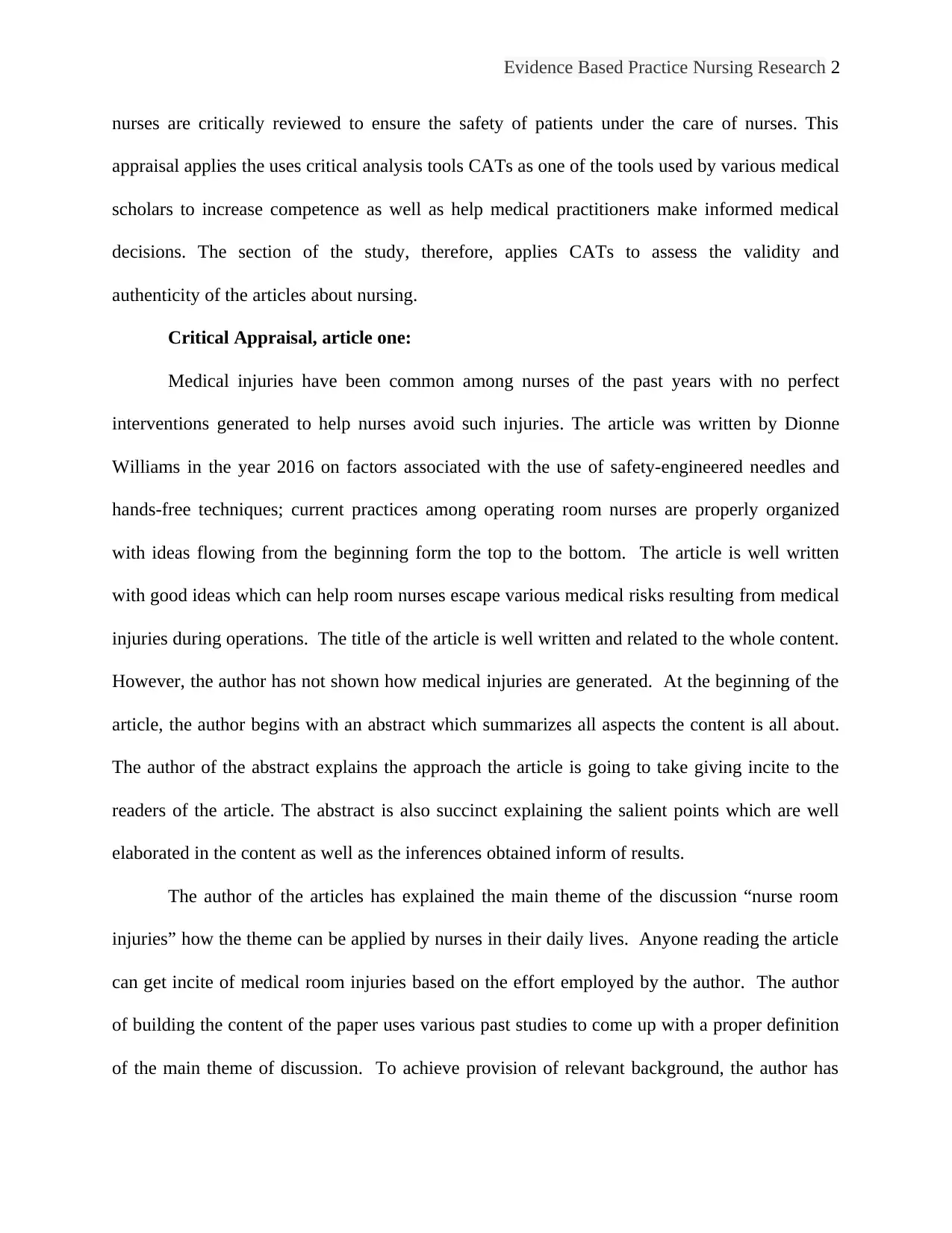
Evidence Based Practice Nursing Research 2
nurses are critically reviewed to ensure the safety of patients under the care of nurses. This
appraisal applies the uses critical analysis tools CATs as one of the tools used by various medical
scholars to increase competence as well as help medical practitioners make informed medical
decisions. The section of the study, therefore, applies CATs to assess the validity and
authenticity of the articles about nursing.
Critical Appraisal, article one:
Medical injuries have been common among nurses of the past years with no perfect
interventions generated to help nurses avoid such injuries. The article was written by Dionne
Williams in the year 2016 on factors associated with the use of safety-engineered needles and
hands-free techniques; current practices among operating room nurses are properly organized
with ideas flowing from the beginning form the top to the bottom. The article is well written
with good ideas which can help room nurses escape various medical risks resulting from medical
injuries during operations. The title of the article is well written and related to the whole content.
However, the author has not shown how medical injuries are generated. At the beginning of the
article, the author begins with an abstract which summarizes all aspects the content is all about.
The author of the abstract explains the approach the article is going to take giving incite to the
readers of the article. The abstract is also succinct explaining the salient points which are well
elaborated in the content as well as the inferences obtained inform of results.
The author of the articles has explained the main theme of the discussion “nurse room
injuries” how the theme can be applied by nurses in their daily lives. Anyone reading the article
can get incite of medical room injuries based on the effort employed by the author. The author
of building the content of the paper uses various past studies to come up with a proper definition
of the main theme of discussion. To achieve provision of relevant background, the author has
nurses are critically reviewed to ensure the safety of patients under the care of nurses. This
appraisal applies the uses critical analysis tools CATs as one of the tools used by various medical
scholars to increase competence as well as help medical practitioners make informed medical
decisions. The section of the study, therefore, applies CATs to assess the validity and
authenticity of the articles about nursing.
Critical Appraisal, article one:
Medical injuries have been common among nurses of the past years with no perfect
interventions generated to help nurses avoid such injuries. The article was written by Dionne
Williams in the year 2016 on factors associated with the use of safety-engineered needles and
hands-free techniques; current practices among operating room nurses are properly organized
with ideas flowing from the beginning form the top to the bottom. The article is well written
with good ideas which can help room nurses escape various medical risks resulting from medical
injuries during operations. The title of the article is well written and related to the whole content.
However, the author has not shown how medical injuries are generated. At the beginning of the
article, the author begins with an abstract which summarizes all aspects the content is all about.
The author of the abstract explains the approach the article is going to take giving incite to the
readers of the article. The abstract is also succinct explaining the salient points which are well
elaborated in the content as well as the inferences obtained inform of results.
The author of the articles has explained the main theme of the discussion “nurse room
injuries” how the theme can be applied by nurses in their daily lives. Anyone reading the article
can get incite of medical room injuries based on the effort employed by the author. The author
of building the content of the paper uses various past studies to come up with a proper definition
of the main theme of discussion. To achieve provision of relevant background, the author has
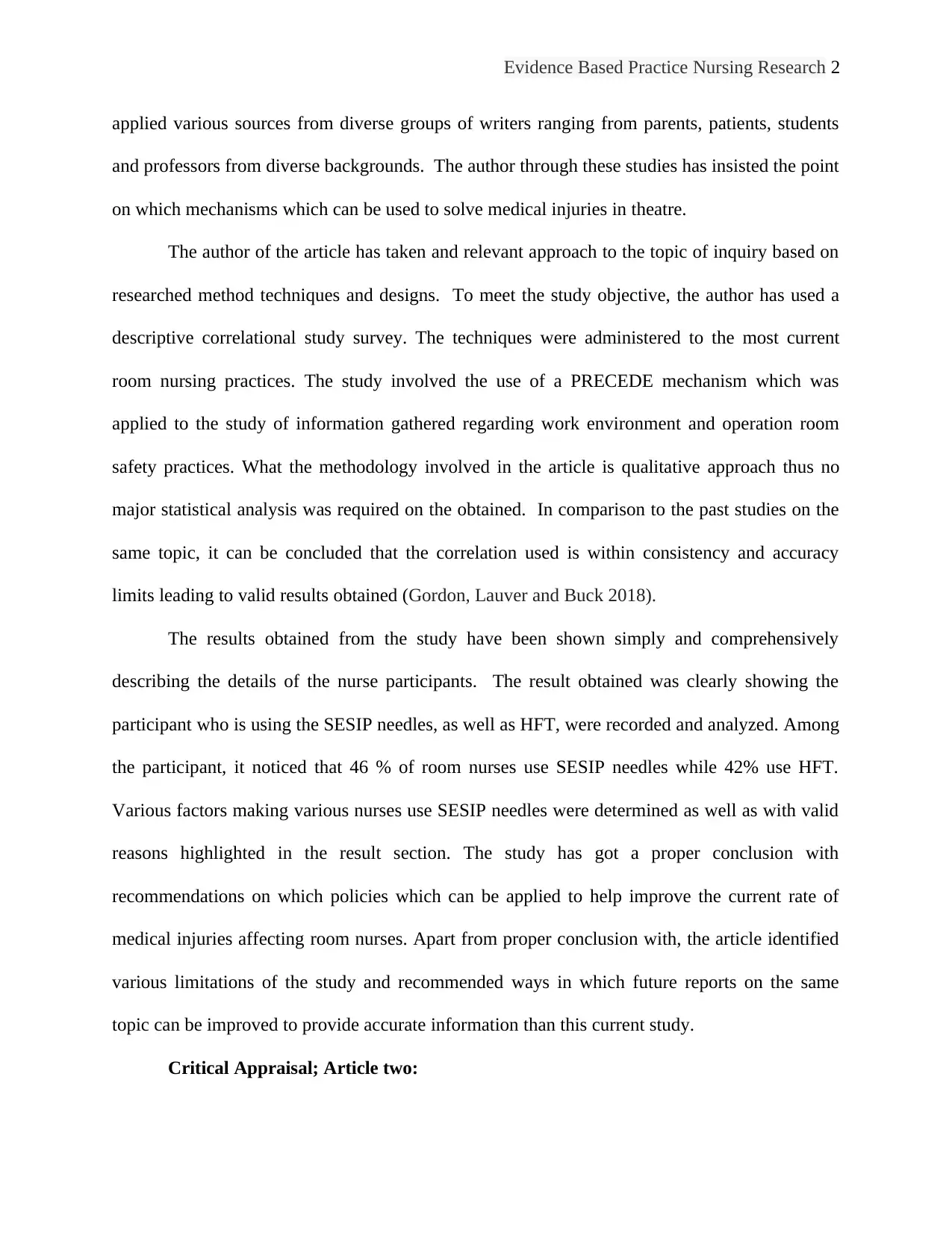
Evidence Based Practice Nursing Research 2
applied various sources from diverse groups of writers ranging from parents, patients, students
and professors from diverse backgrounds. The author through these studies has insisted the point
on which mechanisms which can be used to solve medical injuries in theatre.
The author of the article has taken and relevant approach to the topic of inquiry based on
researched method techniques and designs. To meet the study objective, the author has used a
descriptive correlational study survey. The techniques were administered to the most current
room nursing practices. The study involved the use of a PRECEDE mechanism which was
applied to the study of information gathered regarding work environment and operation room
safety practices. What the methodology involved in the article is qualitative approach thus no
major statistical analysis was required on the obtained. In comparison to the past studies on the
same topic, it can be concluded that the correlation used is within consistency and accuracy
limits leading to valid results obtained (Gordon, Lauver and Buck 2018).
The results obtained from the study have been shown simply and comprehensively
describing the details of the nurse participants. The result obtained was clearly showing the
participant who is using the SESIP needles, as well as HFT, were recorded and analyzed. Among
the participant, it noticed that 46 % of room nurses use SESIP needles while 42% use HFT.
Various factors making various nurses use SESIP needles were determined as well as with valid
reasons highlighted in the result section. The study has got a proper conclusion with
recommendations on which policies which can be applied to help improve the current rate of
medical injuries affecting room nurses. Apart from proper conclusion with, the article identified
various limitations of the study and recommended ways in which future reports on the same
topic can be improved to provide accurate information than this current study.
Critical Appraisal; Article two:
applied various sources from diverse groups of writers ranging from parents, patients, students
and professors from diverse backgrounds. The author through these studies has insisted the point
on which mechanisms which can be used to solve medical injuries in theatre.
The author of the article has taken and relevant approach to the topic of inquiry based on
researched method techniques and designs. To meet the study objective, the author has used a
descriptive correlational study survey. The techniques were administered to the most current
room nursing practices. The study involved the use of a PRECEDE mechanism which was
applied to the study of information gathered regarding work environment and operation room
safety practices. What the methodology involved in the article is qualitative approach thus no
major statistical analysis was required on the obtained. In comparison to the past studies on the
same topic, it can be concluded that the correlation used is within consistency and accuracy
limits leading to valid results obtained (Gordon, Lauver and Buck 2018).
The results obtained from the study have been shown simply and comprehensively
describing the details of the nurse participants. The result obtained was clearly showing the
participant who is using the SESIP needles, as well as HFT, were recorded and analyzed. Among
the participant, it noticed that 46 % of room nurses use SESIP needles while 42% use HFT.
Various factors making various nurses use SESIP needles were determined as well as with valid
reasons highlighted in the result section. The study has got a proper conclusion with
recommendations on which policies which can be applied to help improve the current rate of
medical injuries affecting room nurses. Apart from proper conclusion with, the article identified
various limitations of the study and recommended ways in which future reports on the same
topic can be improved to provide accurate information than this current study.
Critical Appraisal; Article two:
⊘ This is a preview!⊘
Do you want full access?
Subscribe today to unlock all pages.

Trusted by 1+ million students worldwide
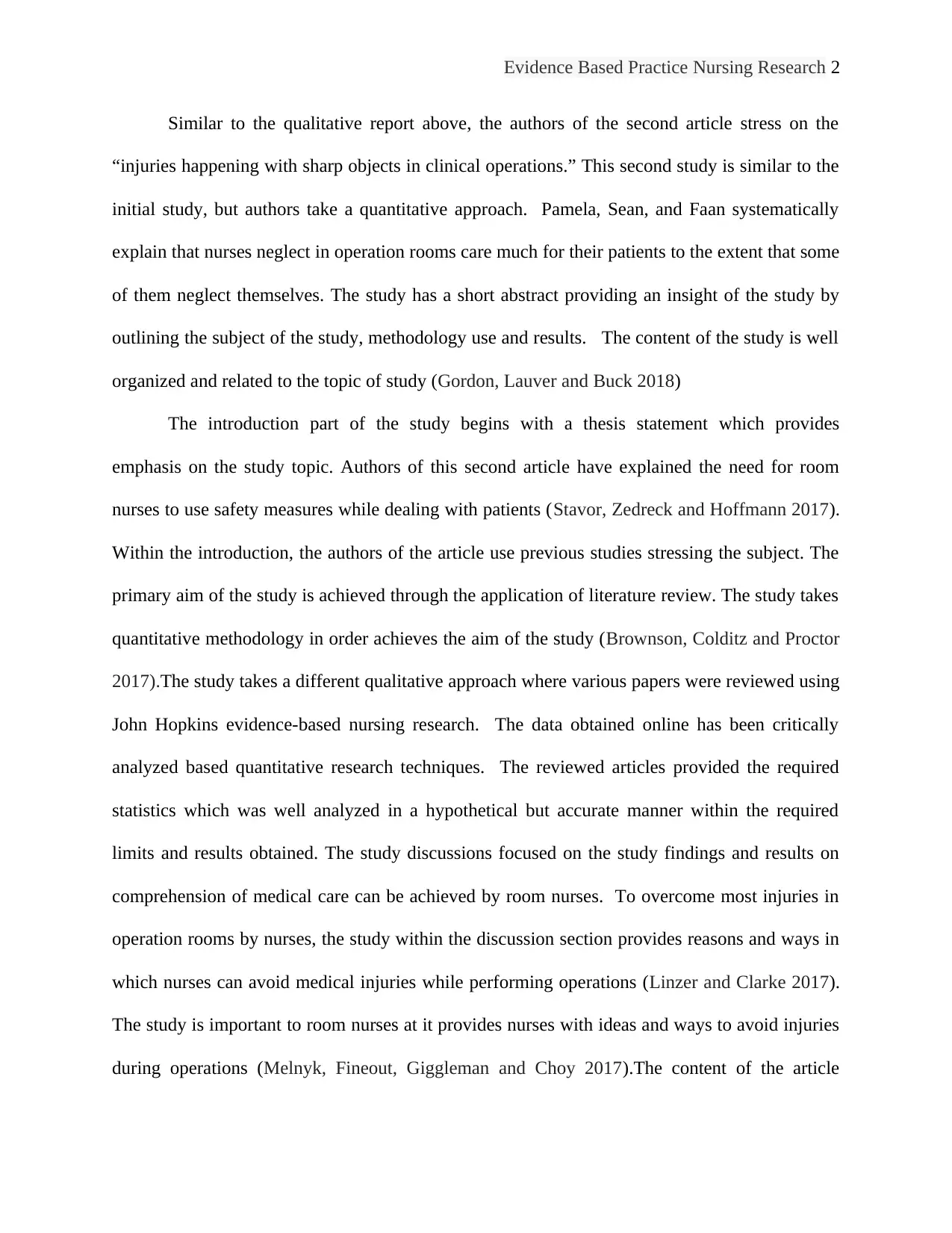
Evidence Based Practice Nursing Research 2
Similar to the qualitative report above, the authors of the second article stress on the
“injuries happening with sharp objects in clinical operations.” This second study is similar to the
initial study, but authors take a quantitative approach. Pamela, Sean, and Faan systematically
explain that nurses neglect in operation rooms care much for their patients to the extent that some
of them neglect themselves. The study has a short abstract providing an insight of the study by
outlining the subject of the study, methodology use and results. The content of the study is well
organized and related to the topic of study (Gordon, Lauver and Buck 2018)
The introduction part of the study begins with a thesis statement which provides
emphasis on the study topic. Authors of this second article have explained the need for room
nurses to use safety measures while dealing with patients (Stavor, Zedreck and Hoffmann 2017).
Within the introduction, the authors of the article use previous studies stressing the subject. The
primary aim of the study is achieved through the application of literature review. The study takes
quantitative methodology in order achieves the aim of the study (Brownson, Colditz and Proctor
2017).The study takes a different qualitative approach where various papers were reviewed using
John Hopkins evidence-based nursing research. The data obtained online has been critically
analyzed based quantitative research techniques. The reviewed articles provided the required
statistics which was well analyzed in a hypothetical but accurate manner within the required
limits and results obtained. The study discussions focused on the study findings and results on
comprehension of medical care can be achieved by room nurses. To overcome most injuries in
operation rooms by nurses, the study within the discussion section provides reasons and ways in
which nurses can avoid medical injuries while performing operations (Linzer and Clarke 2017).
The study is important to room nurses at it provides nurses with ideas and ways to avoid injuries
during operations (Melnyk, Fineout, Giggleman and Choy 2017).The content of the article
Similar to the qualitative report above, the authors of the second article stress on the
“injuries happening with sharp objects in clinical operations.” This second study is similar to the
initial study, but authors take a quantitative approach. Pamela, Sean, and Faan systematically
explain that nurses neglect in operation rooms care much for their patients to the extent that some
of them neglect themselves. The study has a short abstract providing an insight of the study by
outlining the subject of the study, methodology use and results. The content of the study is well
organized and related to the topic of study (Gordon, Lauver and Buck 2018)
The introduction part of the study begins with a thesis statement which provides
emphasis on the study topic. Authors of this second article have explained the need for room
nurses to use safety measures while dealing with patients (Stavor, Zedreck and Hoffmann 2017).
Within the introduction, the authors of the article use previous studies stressing the subject. The
primary aim of the study is achieved through the application of literature review. The study takes
quantitative methodology in order achieves the aim of the study (Brownson, Colditz and Proctor
2017).The study takes a different qualitative approach where various papers were reviewed using
John Hopkins evidence-based nursing research. The data obtained online has been critically
analyzed based quantitative research techniques. The reviewed articles provided the required
statistics which was well analyzed in a hypothetical but accurate manner within the required
limits and results obtained. The study discussions focused on the study findings and results on
comprehension of medical care can be achieved by room nurses. To overcome most injuries in
operation rooms by nurses, the study within the discussion section provides reasons and ways in
which nurses can avoid medical injuries while performing operations (Linzer and Clarke 2017).
The study is important to room nurses at it provides nurses with ideas and ways to avoid injuries
during operations (Melnyk, Fineout, Giggleman and Choy 2017).The content of the article
Paraphrase This Document
Need a fresh take? Get an instant paraphrase of this document with our AI Paraphraser
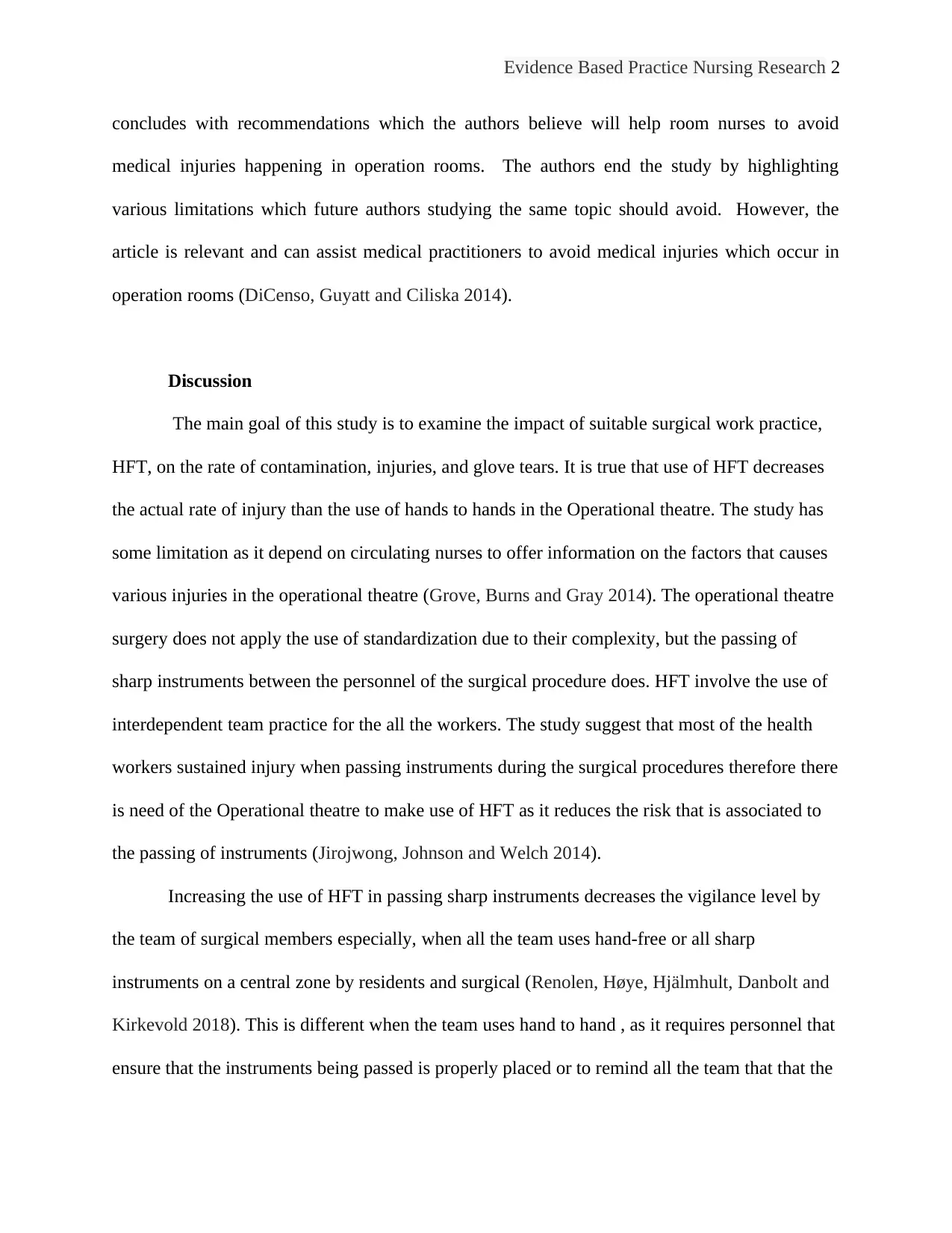
Evidence Based Practice Nursing Research 2
concludes with recommendations which the authors believe will help room nurses to avoid
medical injuries happening in operation rooms. The authors end the study by highlighting
various limitations which future authors studying the same topic should avoid. However, the
article is relevant and can assist medical practitioners to avoid medical injuries which occur in
operation rooms (DiCenso, Guyatt and Ciliska 2014).
Discussion
The main goal of this study is to examine the impact of suitable surgical work practice,
HFT, on the rate of contamination, injuries, and glove tears. It is true that use of HFT decreases
the actual rate of injury than the use of hands to hands in the Operational theatre. The study has
some limitation as it depend on circulating nurses to offer information on the factors that causes
various injuries in the operational theatre (Grove, Burns and Gray 2014). The operational theatre
surgery does not apply the use of standardization due to their complexity, but the passing of
sharp instruments between the personnel of the surgical procedure does. HFT involve the use of
interdependent team practice for the all the workers. The study suggest that most of the health
workers sustained injury when passing instruments during the surgical procedures therefore there
is need of the Operational theatre to make use of HFT as it reduces the risk that is associated to
the passing of instruments (Jirojwong, Johnson and Welch 2014).
Increasing the use of HFT in passing sharp instruments decreases the vigilance level by
the team of surgical members especially, when all the team uses hand-free or all sharp
instruments on a central zone by residents and surgical (Renolen, Høye, Hjälmhult, Danbolt and
Kirkevold 2018). This is different when the team uses hand to hand , as it requires personnel that
ensure that the instruments being passed is properly placed or to remind all the team that that the
concludes with recommendations which the authors believe will help room nurses to avoid
medical injuries happening in operation rooms. The authors end the study by highlighting
various limitations which future authors studying the same topic should avoid. However, the
article is relevant and can assist medical practitioners to avoid medical injuries which occur in
operation rooms (DiCenso, Guyatt and Ciliska 2014).
Discussion
The main goal of this study is to examine the impact of suitable surgical work practice,
HFT, on the rate of contamination, injuries, and glove tears. It is true that use of HFT decreases
the actual rate of injury than the use of hands to hands in the Operational theatre. The study has
some limitation as it depend on circulating nurses to offer information on the factors that causes
various injuries in the operational theatre (Grove, Burns and Gray 2014). The operational theatre
surgery does not apply the use of standardization due to their complexity, but the passing of
sharp instruments between the personnel of the surgical procedure does. HFT involve the use of
interdependent team practice for the all the workers. The study suggest that most of the health
workers sustained injury when passing instruments during the surgical procedures therefore there
is need of the Operational theatre to make use of HFT as it reduces the risk that is associated to
the passing of instruments (Jirojwong, Johnson and Welch 2014).
Increasing the use of HFT in passing sharp instruments decreases the vigilance level by
the team of surgical members especially, when all the team uses hand-free or all sharp
instruments on a central zone by residents and surgical (Renolen, Høye, Hjälmhult, Danbolt and
Kirkevold 2018). This is different when the team uses hand to hand , as it requires personnel that
ensure that the instruments being passed is properly placed or to remind all the team that that the
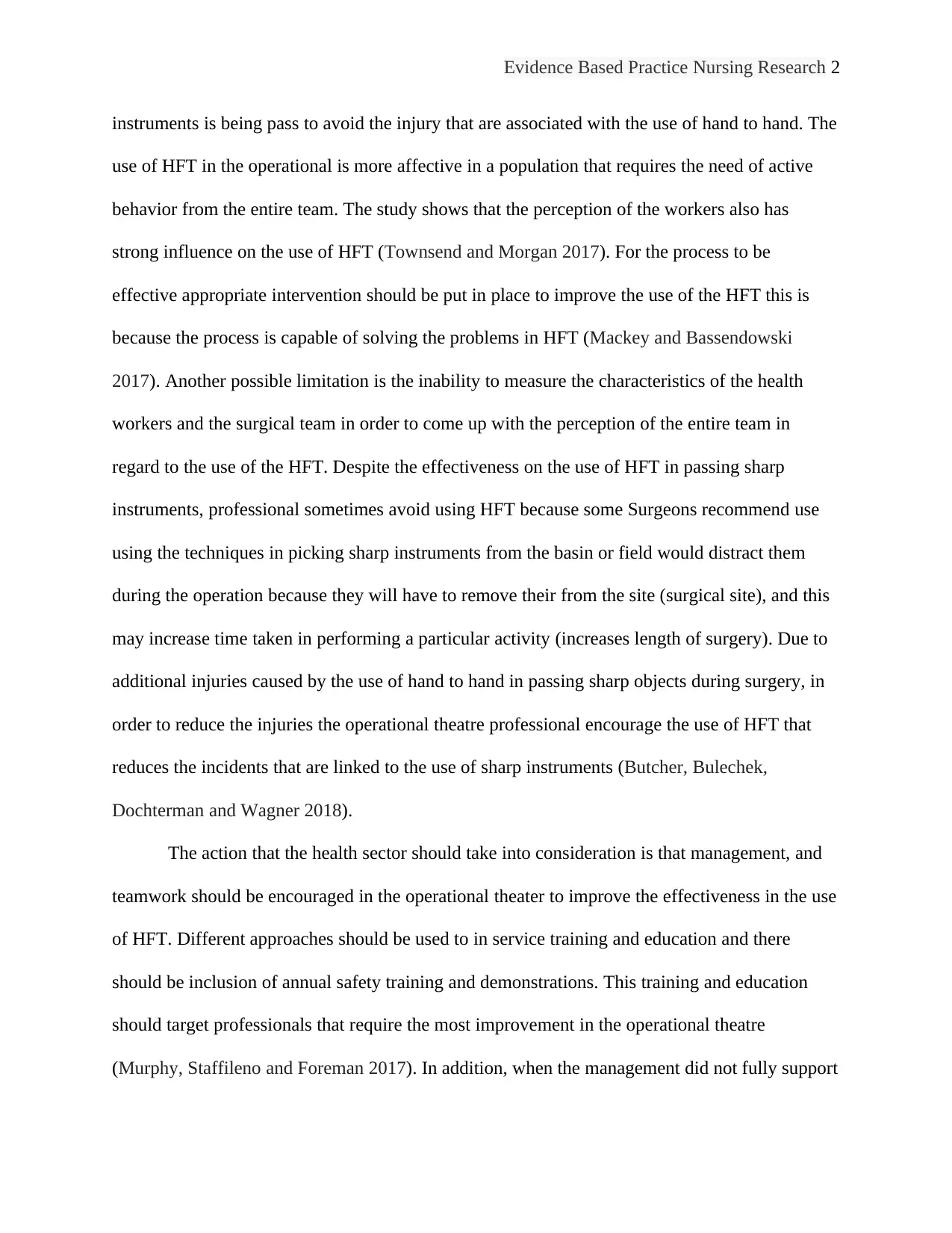
Evidence Based Practice Nursing Research 2
instruments is being pass to avoid the injury that are associated with the use of hand to hand. The
use of HFT in the operational is more affective in a population that requires the need of active
behavior from the entire team. The study shows that the perception of the workers also has
strong influence on the use of HFT (Townsend and Morgan 2017). For the process to be
effective appropriate intervention should be put in place to improve the use of the HFT this is
because the process is capable of solving the problems in HFT (Mackey and Bassendowski
2017). Another possible limitation is the inability to measure the characteristics of the health
workers and the surgical team in order to come up with the perception of the entire team in
regard to the use of the HFT. Despite the effectiveness on the use of HFT in passing sharp
instruments, professional sometimes avoid using HFT because some Surgeons recommend use
using the techniques in picking sharp instruments from the basin or field would distract them
during the operation because they will have to remove their from the site (surgical site), and this
may increase time taken in performing a particular activity (increases length of surgery). Due to
additional injuries caused by the use of hand to hand in passing sharp objects during surgery, in
order to reduce the injuries the operational theatre professional encourage the use of HFT that
reduces the incidents that are linked to the use of sharp instruments (Butcher, Bulechek,
Dochterman and Wagner 2018).
The action that the health sector should take into consideration is that management, and
teamwork should be encouraged in the operational theater to improve the effectiveness in the use
of HFT. Different approaches should be used to in service training and education and there
should be inclusion of annual safety training and demonstrations. This training and education
should target professionals that require the most improvement in the operational theatre
(Murphy, Staffileno and Foreman 2017). In addition, when the management did not fully support
instruments is being pass to avoid the injury that are associated with the use of hand to hand. The
use of HFT in the operational is more affective in a population that requires the need of active
behavior from the entire team. The study shows that the perception of the workers also has
strong influence on the use of HFT (Townsend and Morgan 2017). For the process to be
effective appropriate intervention should be put in place to improve the use of the HFT this is
because the process is capable of solving the problems in HFT (Mackey and Bassendowski
2017). Another possible limitation is the inability to measure the characteristics of the health
workers and the surgical team in order to come up with the perception of the entire team in
regard to the use of the HFT. Despite the effectiveness on the use of HFT in passing sharp
instruments, professional sometimes avoid using HFT because some Surgeons recommend use
using the techniques in picking sharp instruments from the basin or field would distract them
during the operation because they will have to remove their from the site (surgical site), and this
may increase time taken in performing a particular activity (increases length of surgery). Due to
additional injuries caused by the use of hand to hand in passing sharp objects during surgery, in
order to reduce the injuries the operational theatre professional encourage the use of HFT that
reduces the incidents that are linked to the use of sharp instruments (Butcher, Bulechek,
Dochterman and Wagner 2018).
The action that the health sector should take into consideration is that management, and
teamwork should be encouraged in the operational theater to improve the effectiveness in the use
of HFT. Different approaches should be used to in service training and education and there
should be inclusion of annual safety training and demonstrations. This training and education
should target professionals that require the most improvement in the operational theatre
(Murphy, Staffileno and Foreman 2017). In addition, when the management did not fully support
⊘ This is a preview!⊘
Do you want full access?
Subscribe today to unlock all pages.

Trusted by 1+ million students worldwide
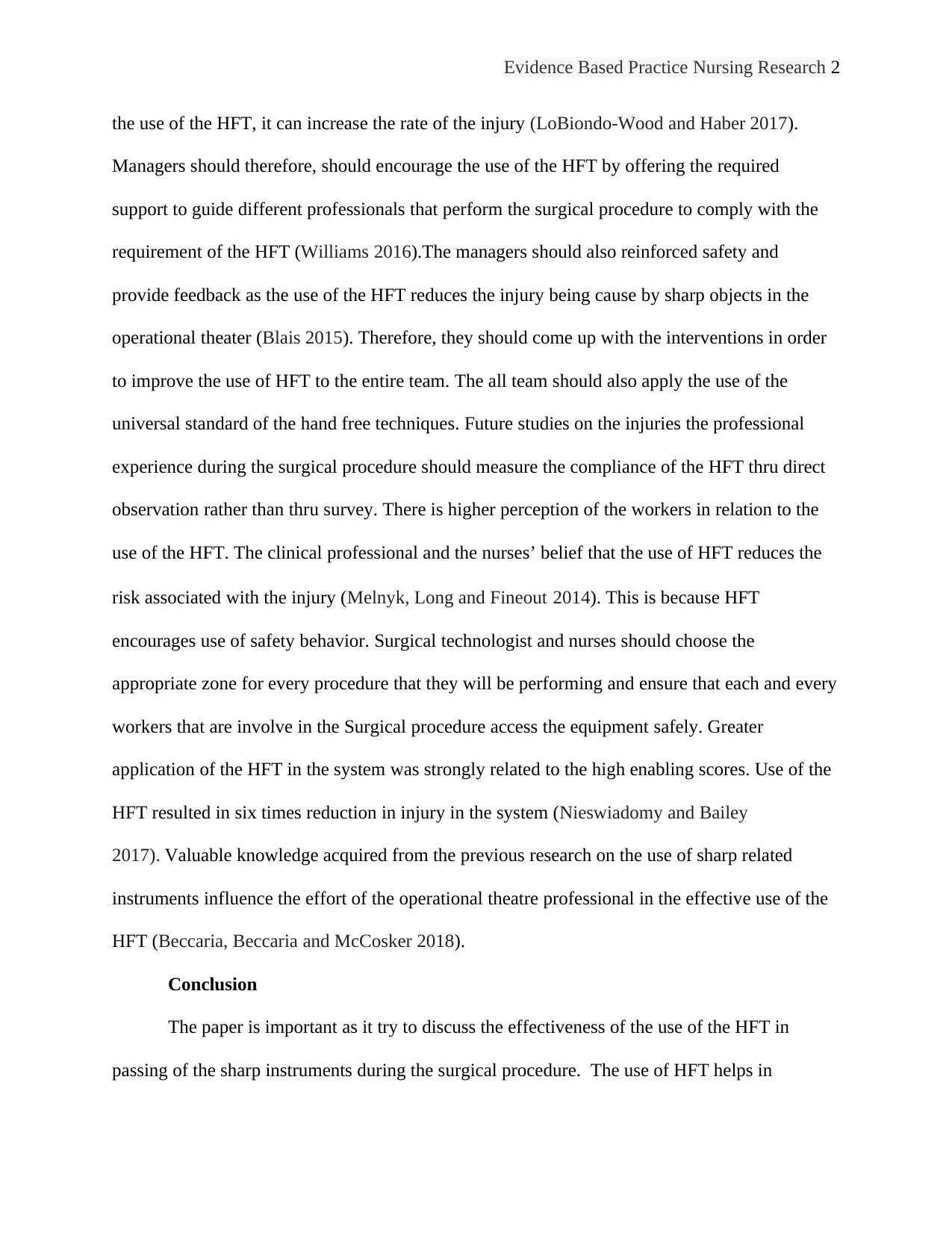
Evidence Based Practice Nursing Research 2
the use of the HFT, it can increase the rate of the injury (LoBiondo-Wood and Haber 2017).
Managers should therefore, should encourage the use of the HFT by offering the required
support to guide different professionals that perform the surgical procedure to comply with the
requirement of the HFT (Williams 2016).The managers should also reinforced safety and
provide feedback as the use of the HFT reduces the injury being cause by sharp objects in the
operational theater (Blais 2015). Therefore, they should come up with the interventions in order
to improve the use of HFT to the entire team. The all team should also apply the use of the
universal standard of the hand free techniques. Future studies on the injuries the professional
experience during the surgical procedure should measure the compliance of the HFT thru direct
observation rather than thru survey. There is higher perception of the workers in relation to the
use of the HFT. The clinical professional and the nurses’ belief that the use of HFT reduces the
risk associated with the injury (Melnyk, Long and Fineout 2014). This is because HFT
encourages use of safety behavior. Surgical technologist and nurses should choose the
appropriate zone for every procedure that they will be performing and ensure that each and every
workers that are involve in the Surgical procedure access the equipment safely. Greater
application of the HFT in the system was strongly related to the high enabling scores. Use of the
HFT resulted in six times reduction in injury in the system (Nieswiadomy and Bailey
2017). Valuable knowledge acquired from the previous research on the use of sharp related
instruments influence the effort of the operational theatre professional in the effective use of the
HFT (Beccaria, Beccaria and McCosker 2018).
Conclusion
The paper is important as it try to discuss the effectiveness of the use of the HFT in
passing of the sharp instruments during the surgical procedure. The use of HFT helps in
the use of the HFT, it can increase the rate of the injury (LoBiondo-Wood and Haber 2017).
Managers should therefore, should encourage the use of the HFT by offering the required
support to guide different professionals that perform the surgical procedure to comply with the
requirement of the HFT (Williams 2016).The managers should also reinforced safety and
provide feedback as the use of the HFT reduces the injury being cause by sharp objects in the
operational theater (Blais 2015). Therefore, they should come up with the interventions in order
to improve the use of HFT to the entire team. The all team should also apply the use of the
universal standard of the hand free techniques. Future studies on the injuries the professional
experience during the surgical procedure should measure the compliance of the HFT thru direct
observation rather than thru survey. There is higher perception of the workers in relation to the
use of the HFT. The clinical professional and the nurses’ belief that the use of HFT reduces the
risk associated with the injury (Melnyk, Long and Fineout 2014). This is because HFT
encourages use of safety behavior. Surgical technologist and nurses should choose the
appropriate zone for every procedure that they will be performing and ensure that each and every
workers that are involve in the Surgical procedure access the equipment safely. Greater
application of the HFT in the system was strongly related to the high enabling scores. Use of the
HFT resulted in six times reduction in injury in the system (Nieswiadomy and Bailey
2017). Valuable knowledge acquired from the previous research on the use of sharp related
instruments influence the effort of the operational theatre professional in the effective use of the
HFT (Beccaria, Beccaria and McCosker 2018).
Conclusion
The paper is important as it try to discuss the effectiveness of the use of the HFT in
passing of the sharp instruments during the surgical procedure. The use of HFT helps in
Paraphrase This Document
Need a fresh take? Get an instant paraphrase of this document with our AI Paraphraser
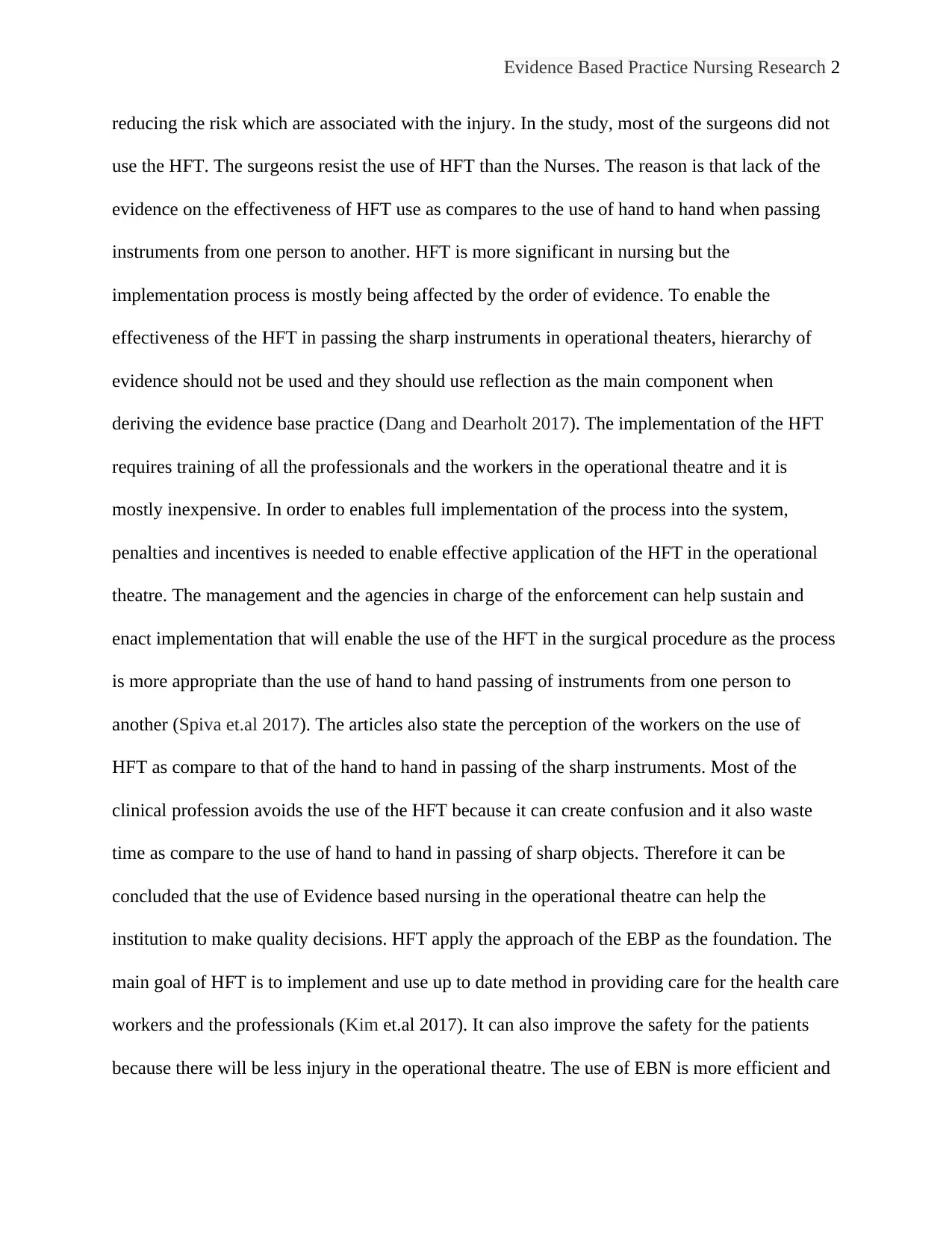
Evidence Based Practice Nursing Research 2
reducing the risk which are associated with the injury. In the study, most of the surgeons did not
use the HFT. The surgeons resist the use of HFT than the Nurses. The reason is that lack of the
evidence on the effectiveness of HFT use as compares to the use of hand to hand when passing
instruments from one person to another. HFT is more significant in nursing but the
implementation process is mostly being affected by the order of evidence. To enable the
effectiveness of the HFT in passing the sharp instruments in operational theaters, hierarchy of
evidence should not be used and they should use reflection as the main component when
deriving the evidence base practice (Dang and Dearholt 2017). The implementation of the HFT
requires training of all the professionals and the workers in the operational theatre and it is
mostly inexpensive. In order to enables full implementation of the process into the system,
penalties and incentives is needed to enable effective application of the HFT in the operational
theatre. The management and the agencies in charge of the enforcement can help sustain and
enact implementation that will enable the use of the HFT in the surgical procedure as the process
is more appropriate than the use of hand to hand passing of instruments from one person to
another (Spiva et.al 2017). The articles also state the perception of the workers on the use of
HFT as compare to that of the hand to hand in passing of the sharp instruments. Most of the
clinical profession avoids the use of the HFT because it can create confusion and it also waste
time as compare to the use of hand to hand in passing of sharp objects. Therefore it can be
concluded that the use of Evidence based nursing in the operational theatre can help the
institution to make quality decisions. HFT apply the approach of the EBP as the foundation. The
main goal of HFT is to implement and use up to date method in providing care for the health care
workers and the professionals (Kim et.al 2017). It can also improve the safety for the patients
because there will be less injury in the operational theatre. The use of EBN is more efficient and
reducing the risk which are associated with the injury. In the study, most of the surgeons did not
use the HFT. The surgeons resist the use of HFT than the Nurses. The reason is that lack of the
evidence on the effectiveness of HFT use as compares to the use of hand to hand when passing
instruments from one person to another. HFT is more significant in nursing but the
implementation process is mostly being affected by the order of evidence. To enable the
effectiveness of the HFT in passing the sharp instruments in operational theaters, hierarchy of
evidence should not be used and they should use reflection as the main component when
deriving the evidence base practice (Dang and Dearholt 2017). The implementation of the HFT
requires training of all the professionals and the workers in the operational theatre and it is
mostly inexpensive. In order to enables full implementation of the process into the system,
penalties and incentives is needed to enable effective application of the HFT in the operational
theatre. The management and the agencies in charge of the enforcement can help sustain and
enact implementation that will enable the use of the HFT in the surgical procedure as the process
is more appropriate than the use of hand to hand passing of instruments from one person to
another (Spiva et.al 2017). The articles also state the perception of the workers on the use of
HFT as compare to that of the hand to hand in passing of the sharp instruments. Most of the
clinical profession avoids the use of the HFT because it can create confusion and it also waste
time as compare to the use of hand to hand in passing of sharp objects. Therefore it can be
concluded that the use of Evidence based nursing in the operational theatre can help the
institution to make quality decisions. HFT apply the approach of the EBP as the foundation. The
main goal of HFT is to implement and use up to date method in providing care for the health care
workers and the professionals (Kim et.al 2017). It can also improve the safety for the patients
because there will be less injury in the operational theatre. The use of EBN is more efficient and
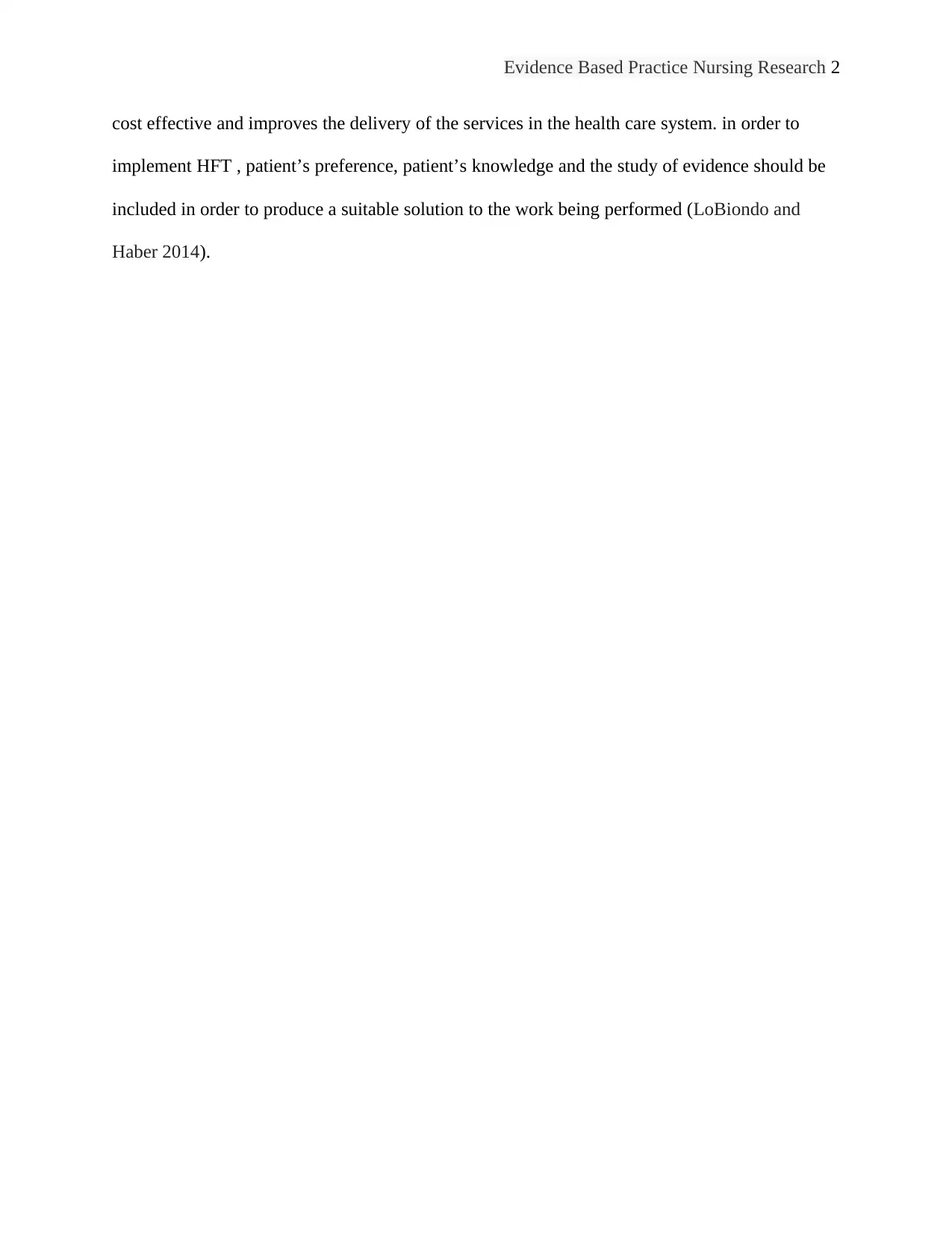
Evidence Based Practice Nursing Research 2
cost effective and improves the delivery of the services in the health care system. in order to
implement HFT , patient’s preference, patient’s knowledge and the study of evidence should be
included in order to produce a suitable solution to the work being performed (LoBiondo and
Haber 2014).
cost effective and improves the delivery of the services in the health care system. in order to
implement HFT , patient’s preference, patient’s knowledge and the study of evidence should be
included in order to produce a suitable solution to the work being performed (LoBiondo and
Haber 2014).
⊘ This is a preview!⊘
Do you want full access?
Subscribe today to unlock all pages.

Trusted by 1+ million students worldwide
1 out of 16
Related Documents
Your All-in-One AI-Powered Toolkit for Academic Success.
+13062052269
info@desklib.com
Available 24*7 on WhatsApp / Email
![[object Object]](/_next/static/media/star-bottom.7253800d.svg)
Unlock your academic potential
Copyright © 2020–2025 A2Z Services. All Rights Reserved. Developed and managed by ZUCOL.





